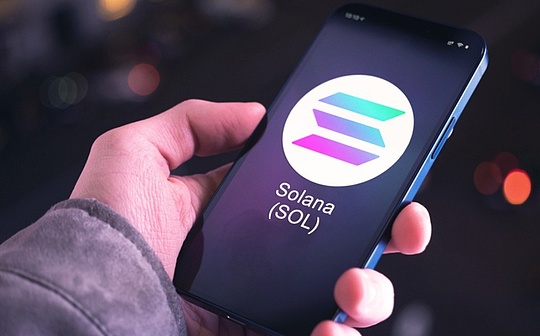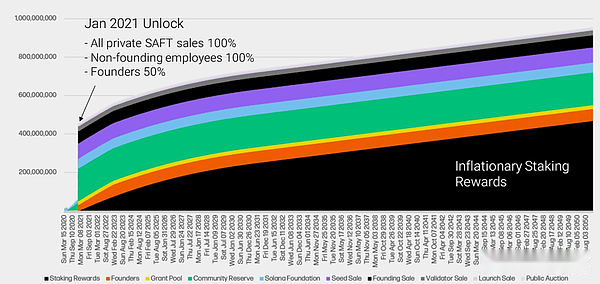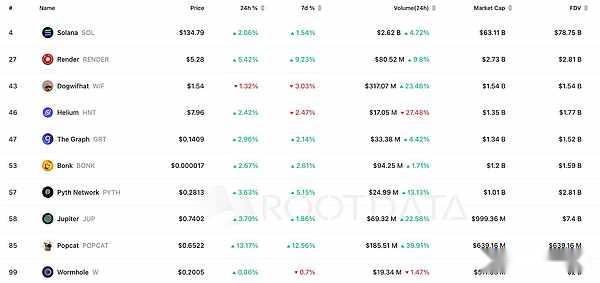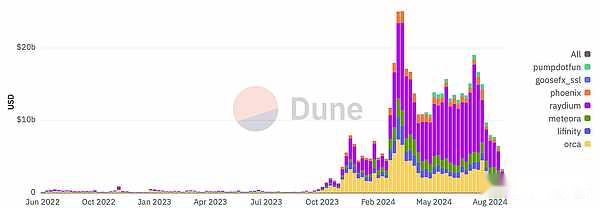
Author: nsights4vc Source: substack Translation: Shan Oppa, Bitchain Vision
With a market capitalization of approximately US$63 billion, Solana is one of the leading blockchain platforms.It has become the first choice for introducing off-chain users, especially in areas such as decentralized physical infrastructure networks (DePINs), mobile applications and payments.In previous articles, we highlighted DePIN built on Solana, includingHeliumandHivemapper.
Solana has made great strides over the past year, especially after Visa announced plans to expand the stablecoin capabilities on the Solana blockchain, its native token price surged.At the 2024 Consensus Conference, PayPal Holdings, Inc. (NASDAQ: PYPL) revealed that PayPal USD (PYUSD) is now available on Solana, making PayPal’s stablecoins faster and more cost-effective (currently, PYUSDThe market value is US$827.83 million, of which 58.3% are on Solana and 41.7% are on Ethereum).
Core team:
-
Founder and CEO:Anatoly Yakovenko
-
Co-founder:Raj Gokal
-
Co-founder and Chief Technology Officer:Greg Fitzgerald
-
Co-founder:Stephen Akridge
-
Co-founder and chief scientist:Eric Williams
Solana Financing Insights – Total Financing: $359.55 million
Financing round:
-
Seed Round: Date:First quarter of 2018 |Funding amount:$3.17 million |price:$0.04
-
Private Equity Round: Date:Second Quarter 2018 |Fundraising amount:$12.63 million |price:$0.2
Major investors:Jump Crypto, BlockTower Capital, Distributed Global, Reciprocal Ventures, etc.
-
Series A Financing: Date:Second Quarter 2019 |Funding amount:$20 million
Major investors:Multicoin Capital(lead investment),Distributed Global, Slow Ventures, RockawayX, NGC Ventures, Blockchange Ventures, etc.
-
Verification Round: Date:2019 Q3 |Amount of funds raised:$5.7 million |price:$0.225
-
Private placement/presale: Date:January 2, 2020 |Fundraising amount:$2.29 million |price:$0.250
-
Strategy Round: Date:First quarter of 2020 |Fundraising amount:$2.29 million |price:$0.25
-
ICO: Date:March 23, 2020 |Amount of funds raised:$1.76 million |price:$0.220 |platform:Coinlist
-
TGE and Distribution: Date:April 10, 2020 |Listing price:$0.67
-
Undisclosed Round: Date:June 9, 2021 |Funding amount:$314 million
Major investors:Andreessen Horowitz (a16z)(lead investment),Polychain Capital(lead investment),Multicoin Capital, CMS Holdings, Ryze Labs (Sino Global Capital), Alameda Research, Jump Trading, etc.
Solana (SOL) Token Economics (September 12, 2024)
-
SOL Total Supply:584,294,896 SOL
-
Circulation supply: 467,932,073 SOL (80.1%)
-
Non-circulating supply: 116,362,823 SOL (19.9%)
-
Market value: US$63.3 billion (overallRanked 5, accounting for the total cryptocurrency market ($2.04 trillion)3.104%)
-
Pledge supply: 383,399,756.5 SOL (65.6% of total supply)
-
Lock staking SOL: 48,163,740.1 SOL (accounting for 12.6% of the total pledge)
-
Inflation rate: The current inflation rate is 5.036%, a decrease of 15% per year, and the final inflation rate is 1.5%
-
Supply News: Pledged SOLs include active and unpledged assets; locked assets are temporarily frozen to a specific date, usually part of an investment or grant from the Solana Foundation and Solana Labs.
-
Cost structure: 50% of the transaction fee is destroyed; the remaining part is rewarded to the validator as a block.
Solana’s inflation mechanism
Token issuance and reductionSolana’s SOL tokens are introduced through two main mechanisms: Genesis Block and Protocol Inflation (Staking Reward).Instead, SOL tokens are removed from circulation mainly through transaction fee destruction.The inflation plan is controlled by three parameters: the initial inflation rate is 8%, the deflation rate is -15%, and the long-term inflation rate is 1.5%.The current inflation rate is 5.07%, with Solana’s inflation beginning at the 150th epoch in February 2021.

Impact on Internet participantsProof of Stake (PoS) Inflation essentially transfers wealth from non-pledgers to pledgers, effectively diluting the value of holdings of non-pledgers while rewarding those involved in pledges.Solana maintains a high stake rate of 65%, which is quite high compared to other networks.As of now, about 380 million SOLs have been pledged and have changed significantly over various periods.

Calculation of pledge yield
The yield on pledge is affected by inflation, validator uptime, commission rate and SOL percentage of pledge.The formula is:

Cost destruction and deinflation factors:
Destruction of transaction fees, substantial cuts and other user-related losses will all exacerbate deflation pressures, although the impact is small.Transaction fee destruction peaked at 7.8% in March 2024, but recently averaged 3.2%.After SIMD-96 implementation, the impact of these destructions will become insignificant.Despite possible significant cuts, this is rare and is not an important deflationary factor at the moment.
Taxation and market impact:
In many jurisdictions, receiving an inflation reward can be a taxable event, which can cause selling pressure from pledges who need to bear the tax burden.In addition, PoS inflation may put ongoing downward pressure on SOL prices, affecting fair price comparisons and the network economy.
Validator income and inflation dependency:
Validators have traditionally relied on inflation commissions, but recent growth in alternative income sources such as MEV (maximum withdrawable value) and block rewards provide new avenues for sustainable income.The long-term sustainability of these alternative sources remains uncertain.
Inflation parameters and scenarios (Source: Helius)
Solana’s inflation is currently guided by an initial inflation rate of 8%, deflation rate of -15%, and a long-term inflation rate of 1.5%.As of September 2024, the current inflation rate is about 5%, with a total supply of 584 million SOL.Four solutions are proposed to explore potential changes:
-
Scenario A:The deflation rate doubled from -15% to -30%.
-
Scenario B:The long-term inflation rate dropped from 1.5% to 0.75%.
-
Scenario C:Immediately cut the current inflation rate from 5% to 2.5%.
-
Scenario D:Cut the current inflation rate by half, double the deflation rate, and cut the long-term inflation rate by half.

Impact on supply and price:
In the next eight years:
-
Scenario A:Total supply decreased by 5.3% (to 678 million SOL).
-
Scenario B:Minimum impact, reducing supply of only 1 million SOL.
-
Scenario C:Total supply decreased by 7.3% (to 664 million SOL).
-
Scenario D:Total supply decreased by 12.2% (to 629 million SOL).

Assume the starting price is $150 per SOL and keep the other variables unchanged:
-
Baseline:Current inflation plans cut prices by 18.5% to $122.25.
-
Scene A:Prices were reduced by 13.93% to $129.10.
-
Scene C:Prices were reduced by 12.07% to $131.90.
-
Scene D:Prices were reduced by 7.26% to $139.10.
Architecture
Solana is a high-performance blockchain designed for speed, efficiency and scalability.It supports thousands of transactions per second, with low latency and extremely low fees, with blocking time of 400 milliseconds and a cost of just one-cent.This report explores Solana’s mechanisms and architecture, emphasizing its ability to seamlessly scale and interact in a unified ecosystem.
programming language
Solana mainly uses Rust for smart contracts because of its concurrency, memory security, and low-level control to ensure code is secure and predictable.Although Rust is the primary language, Solana supports all LLVM-compatible languages, such as C and C++, allowing a wider range of developers to participate.For client development, Solana provides Java, C#, Python, Go, and Kotlin SDKs to facilitate communication with the Solana network through the JSON RPC API.This diverse language support enhances developers’ accessibility and flexibility.
Mechanism and architecture
Solana’s architecture utilizes a unified, composable ecosystem to integrate all applications onto a single blockchain.This design avoids the need for bridges, separate chain IDs, or liquidity fragmentation, thereby enhancing the user experience and simplifying interactions between applications.The nature of blockchain is due to its ability to make full use of hardware capabilities, ensuring that software can expand as hardware advances.
Solana’s transaction process begins with the user submitting a transaction to the leader, who compiles the transaction into blocks and propagates it to the network for other validators to execute and confirm.Core protocol changes are managed through Solana Improvement Documentation (SIMD) and are reviewed and voted by the community.
Trading life cycle
Solana transactions are the only way to change state within a blockchain.Each transaction or “transaction message” contains the header, account address, the most recent block hash, and instructions.Transactions are atomic and ensure that all operations in the transaction are completely successful or failed.This structure allows predefined optimizations to facilitate conflict-free transactions parallel execution by requiring pre-listing of accounts.

Solana uses Ed25519 elliptic curve encryption technology to process public-private key pairs, ensuring strong security and efficient transaction signatures.The wallet generates a key pair where the public key is used as an account identifier on the blockchain and the private key is used for authorization.Transactions are signed with private keys to ensure integrity and authenticity, and then verified using public keys.
Network operation
Solana takes a leader-based approach, without a memory pool, designates a specific validator as the leader to process transactions over a fixed time period (400 milliseconds).Verifiers are selected based on stakes, and they rotate roles based on a scheduled schedule, thereby enhancing the decentralization and security of the system.
The network uses equity-weighted quality of service (SWQoS) to prioritize transactions from stakeholder validators, thereby reducing the impact of spam and Sybil attacks.SWQoS retains 80% of leader capacity for transactions routed by stakeholder validator, with the rest allocated to non-stakeholder nodes.
Enhanced scalability
Recent scaling solutions such as SVM rollup and ZK compression are under development to further enhance Solana’s performance, although they are still in the early stages of adoption.Blockchain adopts QUIC network protocol to enable efficient, secure and scalable transaction message transmission to meet high throughput requirements.
Consensus and block generation
Solana’s consensus mechanism is built using continuous blocks, and leaders build and broadcast blocks in real time during their time periods.This approach reduces latency and optimizes transaction processing.The transaction processing unit (TPU) of the validator manages block creation, executing transactions in parallel as much as possible to maximize throughput and efficiency.
Proof of History (PoH)
A detailed description of the historical proof mechanism can be found in the Solana white paper.
Proof of History (PoH) is a key feature of Solana that acts as an encrypted clock that enables network synchronization by establishing a verifiable sequence of events.Unlike consensus algorithms such as proof of work, PoH is not used to reach consensus, but to provide time references that validators use to sort transactions and to adhere to leaders’ timelines.
PoH runs by continuously computing the SHA-256 hash chain, where each hash depends on the output of the previous hash.This sequence must be calculated in order to create a “micro-proof of work”.Verifiers run PoH services that generate these hashes, which are difficult to generate, but other validators are easy to verify.By embedding transaction data into this hash chain, PoH timestamps the transaction, demonstrating the order in which transactions occur and preventing validators from manipulating the block sequence.
Mechanisms and functions
Each Solana validator continuously runs the PoH service, hashing in sequence to maintain the encrypted timestamped ledger.When the current leader processes new transactions, these transactions will be combined with the current PoH hash, updating the chain and embedding the transactions into the encrypted timeline.This process ensures that leaders cannot manipulate the timing or sequence of transactions.
In each 400 millisecond block, the PoH stream contains approximately 800,000 hashes and “ticks”, marking the passage of time at intervals of 6.25 milliseconds.These tickings serve as evidence of activity and maintain the rhythm of network operation.Even without being a leader, validators keep their PoH clock running to synchronize with the rest of the network and ensure compliance with the leader schedule.
Account Model
Solana’s state management relies on AccountsDB, which is structured as a large key-value store where the key is the account address and the value is the corresponding data.There are many types of Solana accounts:
-
User Account: Represents an individual user who owns the private key.
-
Data Account: Store status information, such as token balance.
-
Program Account: Contains executable bytecode for a specific program.
-
Native program account: Execute core network functions.
Solana distinguishes code and state by keeping the program account unchanged, which is stored in a separate account.This separation allows efficient state management and optimizations unique to Solana architecture.
Program and state management
Programs on Solana are written in languages such as Rust and are used to manipulate account data, but they do not store state in themselves.Instead, the program interacts with the program derived address (PDA), a special account that does not have a private key and is controlled by the program.PDA ensures that only associated programs can modify states, thereby enhancing security and program control over state changes.
Rent and Account Management
To alleviate the swelling of the state, Solana has implemented a rental mechanism that requires accounts to maintain a minimum SOL balance.You can close the account when no longer needed and return the rent balance to the user.This approach encourages effective state utilization and prevents unnecessary accounts from staying open indefinitely.
Turbine: Data propagation
Turbine is Solana’s data dissemination protocol inspired by BitTorrent.It breaks down transaction data into small packets called “fragments” and then spreads over the network in a structured way.Fragments are grouped into batches and broadcasted through the Turbine Tree, where validators are organized by layer to relay the fragments to others.This reduces the data load of leaders and improves the network’s ability to effectively distribute blocks.
Consensus: Tower BFT
Solana uses Tower BFT, a custom implementation of practical Byzantine fault tolerance (PBFT), enhanced by PoH’s synchronous clock.This approach reduces communication overhead during consensus because validators rely on pre-set transaction sequences in PoH rather than multiple rounds of messaging.Verifiers vote on blocks using points obtained from the correct vote, and the system ensures that validators stick to their chosen fork for the shortest time, thus minimizing the possibility of fork.
Gossip and Archives
Solana’s Gossip network acts as a control plane that propagates critical metadata and ensures nodes can communicate and synchronize state throughout the network.Archive nodes maintain the network’s history and store data in warehouse nodes to ensure the availability of past transactions.
Economics and Jito
Solana’s economic model includes inflation-based staking rewards, where validators earn SOLs by participating in consensus and generating blocks.Block rewards include transaction fees, which are partially destroyed and partially rewarded to production leaders.Liquid staking enables SOL holders to stake their tokens in a pool, receiving Liquid staking tokens (LSTs) that can be traded or used between applications, while receiving staking rewards.
Jito client is widely adopted by Solana validators, which enhances economic incentives by implementing an off-protocol block space auction system, allowing transactions to be prioritized through tips and standard transaction fees.This greatly improves validator rewards and promotes widespread adoption of Jito clients in the Solana network.
Solana Virtual Machine (SVM)
Solana Virtual Machine (SVM) is an innovative framework designed to manage the maximum extractable value (MEV) in the Solana blockchain.MEV involves withdrawing additional value from transactions by reordering, including or excluding from blocks.SVM provides technologies and protocols to detect, analyze, and manage MEV activities, thereby increasing the efficiency, equity and security of the Solana ecosystem.

SVM differs from Ethereum Virtual Machines (EVMs) in terms of smart contract execution and transaction processing.In SVM, each validator executes a smart contract individually, thus achieving high transaction throughput.In contrast, EVM requires node consensus to execute, so processing is slower.In addition, Solana’s parallel processing model can execute multiple transactions simultaneously, while Ethereum’s sequential model processes one transaction at a time, which makes Solana faster and more efficient.
Purpose and importance of SVM
SVM aims to solve the MEV problem by providing a structured approach to prevent manipulation in transaction sorting and block verification.This is crucial to maintaining the integrity of financial interactions on Solana, protecting users from behaviors such as preemptive transactions, and enhancing the credibility of the network.Given Solana’s high transaction throughput, effective MEV management is essential to prevent rapid value extraction that could harm the average user.
Defining Solana Virtual Machine
In the Solana ecosystem, people think of SVMs differently.Some believe it covers a complete transaction processing pipeline, including validator runtime and program execution, while others focus on lower-level eBPF virtual machines responsible for executing programs.Generally, SVM is understood as a comprehensive system involving the Bank component of the Agave validator that manages the state of each time slot.SVM processes transactions in batches, each batch contains instructions for a specific program and uses a caching mechanism to optimize execution efficiency.
Opportunities for SVM
The decoupled and well-defined interface of SVM allows a variety of applications outside of the Solana validator, including:
-
Off-chain services:Simulates off-chain transaction processing of Solana for simulation and testing.
-
Lightweight client:Provides proof of fraud for lightweight clients, enhanced scalability and security.
-
Status channel:Use SVM-based state channels to manage point-to-point connections and publish the final results to the main chain.
-
Rollups:As the execution layer of Rollups to enhance scalability without the need for full consensus protocol overhead.
-
Avalanche Subnet:Integrate with the Avalanche module for consensus and networking.
-
Extended SVM:Custom SVM units for specific protocols for enhanced flexibility.
SVM is now available through the solana-svm Rust package, supporting a wide range of applications and driving innovation within the Solana ecosystem.
FTX
However, Solana faces challenges following the FTX crash, and this important entity that is closely linked to its ecosystem has problems.FTX founder Sam Bankman-Fried (SBF), a major supporter of Solana, bringing traditionally Ethereum-related projects such as Serum DEX into Solana.Under the influence of SBF, FTX has become one of the world’s largest centralized exchanges, further increasing Solana’s popularity.Unfortunately, FTX misused company assets and customer deposits for high-risk investments, which ultimately led to its collapse, posing significant risks to the Solana ecosystem linked to FTX.On September 12, FTX/Alameda Research unstaked $SOL worth $24 million, and Solscan data shows that the wallet still holds more than $1 billion in $SOL, including pledged and locked tokens.Despite these challenges, the core developer community that aligns with Solana’s philosophy remains committed.Solana restores community trust by enhancing network stability, creating a more friendly development environment, and solving technical problems.
Selected projects based on Solana blockchain

-
Neon EVM:Neon EVM allows Ethereum-based applications to run on Solana, providing faster processing speeds, lower costs, and access to Solana parallel processing.
-
Eclipse:Ethereum Layer 2 solution leverages Solana’s SVM, checkout using Ethereum and use zero-knowledge proof to ensure security.
-
Nitro:Bridge Solana to the Cosmos and IBC ecosystems for enhanced interoperability and liquidity access.
-
Wormhole:Cross-chain bridges enable seamless asset and message transmission across multiple blockchains, including Solana.
-
Allbridge:Cross-chain bridges to facilitate asset transfer between Solana and other blockchains, enhancing Solana’s interoperability.
-
LI.FI:A liquidity aggregation protocol that integrates multiple bridging solutions and DEX aggregators for cross-network switching.
DePIN Project
-
Helium :A decentralized wireless network that uses Solana to enable scalability, supports IoT devices and provides cost-effective connectivity solutions.
-
Hivemapper:A decentralized map network where users who use dashcam to provide real-time road images will receive token rewards.
-
Render Networkandio.net: SolanaDistributed GPU computing networks on 3D rendering and AI tasks provide scalable and cost-effective computing power.
-
IoTeX:A Web3 infrastructure platform that connects smart devices and real-world data to blockchain to improve data accuracy and practicality.
-
Teleport:Decentralized ride-sharing service on Solana provides drivers with lower costs and higher revenue through blockchain-based protocols.
DeFi Project
-
Marinade Finance:A liquid staking platform on Solana allows users to receive staking rewards while maintaining liquidity through mSOL tokens.
-
Jito:A protocol that optimizes MEV profits through liquidity staking aimed at enabling permissionless operations in the Solana ecosystem.
-
Sanctum:A liquidity sharing solution for liquid staking tokens on Solana enables seamless interaction and revenue generation.
-
Drift Protocol:Decentralized trading platform on Solana, offering spot and perpetual trading and real-time price updates.
-
Jupiter:Solana’s leading DEX aggregator provides efficient trading routes, limit orders and perpetual transactions.
-
Zeta Markets:Decentralized derivatives trading protocol on Solana supports options and futures trading.
-
marginfi:A decentralized lending protocol that provides integrated financial activity in a variety of DeFi protocols on Solana.
-
Kamino:A DeFi platform for strategic financial activities, including lending, liquidity provision and portfolio management.
-
Parcl:A partial real estate investment platform that uses data feeds to track real estate prices.
Other projects (NFT and Memecoins, etc.)
-
Magic Eden:Leading NFT marketplace on Solana, supporting multiple chains and providing user-friendly interfaces and low fees.
-
Tensor:Design markets for professional NFT traders, integrating AMM and real-time data capabilities.
-
Metaplex:A platform that provides tools to create, sell and manage digital assets on Solana.
-
DRiP:An NFT delivery platform that supports new artists on Solana with affordable coins and free NFT art coin.
-
TipLink:A lightweight wallet that easily transfers assets through a link or QR code, accessible via Gmail or Solana accounts.
-
Solchat:Communication protocols on Solana for on-chain messaging and P2P calls are expected to be combined with Solana’s mobile ecosystem.
-
Dialect:A decentralized messaging protocol that supports token transfer through messages on Solana.
-
Mad Lads:Coral’s xNFT family explores NFT as a decentralized application that revitalizes the Solana community.
-
MonkeDAO:The first NFT DAO on Solana, originated from Solana Monkey Business, participates in various community-led programs.
-
Superteam DAO:A DAO that promotes Solana in emerging markets supports innovative projects through community-driven efforts.
-
Solana University:An international student organization that provides educational resources and activities for Solana and Web3.
-
Memecoins: $BONK; $WIF, $POPCAT
Key Indicators (September 12, 2024)


















